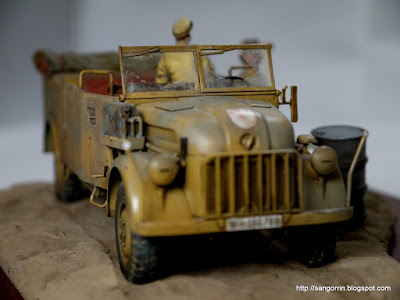This will be the last post for today and I will explain the process I used to create a diorama for the Tamiya German Steyr 1/35 kit.
This kit is quite good, much better than what I thought. All the parts fit great and there are a lot of extra objects and even figures that are not included even in the manual.
When I assembled the kit, one of the things I liked the most was how easily they solved the modeling of this net using this thin clothing. No need for metal parts here.
After assembling the kit, I applied a coat of Mr. Color surfacer Oxide red. I like using this surfacer because if the base color had a cut, you would see some rusty color which is fine.
After letting the surfacer dry, I airbrushed the base colors. Here I am using acrylic gouache colors because the are not toxic, they don't smell and they are super cheap in Japan.
Next, using acrylic gouache as well, I painted all the small objects and details.
After that, I applied a coating of lacquer glossy varnish to protect the acrylic gouache from the next steps.
Although I typically use Mr. Weathering color for the pin washes here I decided to try oil paint. Before using the oil paint, I put it into a piece of kitchen paper and let it absorb the linseed oil that comes with the paint. That will make the paint dry faster when we apply it to the model. You can use any artistic solvent you prefer but I suggest using odorless petroleum. Otherwise, scale modeling thinners such as MIG:s enamel odorless thinner or Mr. Weathering solvent 110 work as well.
Next, I added some streaking effects and chipping all over the vehicle using the same oil paints. It's important not to overdo it. For the chipping, I learned some good tricks from
YouTube.
For the front windows, I applied a very diluted solution of Mr. Weathering color grayish brown.
The kit comes with many figures but I will only use 3 of them for my diorama. I painted the figures by brush using again acrylic gouache.
Then, I applied a lacquer varnish coating and some washes to give the impression of 3D. The most difficult part was painting the face and in particular the eyes. This huge magnifying glass made the job a little bit easier.
For the ground, I used material bought from the 100 yen store. First, I cut out some color boards and glued brown soft clay on top. I placed the vehicle on the clay to create marks and then, I covered the ground with Mr. Weathering paste. This
YouTube tutorial helped me a lot.
For the diorama plate, I reused the lettering design from the kit's box. Using a laster printer, I printed an inverted version of the design on pattern transfer paper (yellow). Then I attached the paper to a copper plate and put it through a laminator multiple times. The heat coming from the laminator causes the laser toner to dissolve and get attached to the copper plate. After that, I used ferric chloride to etch the uncovered copper.
I used a small piece of wood from the 100 yen store for the base. To make it look better, I applied multiple layers of water-based acrylic varnish with mahogany color. It's important to apply thin layers and sand them off before applying the next layer.
Making this diorama took me way more time than what I had expected but I learned many new techniques and tricks in the way so I am glad I built it.


































